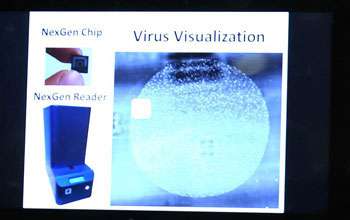Pioneering effort to detect Ebola

According to the World Health Organization, the Ebola outbreak that started in West Africa in 2014 has sickened nearly 30,000 people, killing about one third of them. Detection of the Ebola virus is currently the only way to keep the disease from spreading.
In the past, Ebola diagnostic tests, or assays, have been considered reliable only up to a point. The Ebola virus doesn't use DNA to store its genetic code. It uses a chemical cousin, called RNA, and extracted RNA degrades easily; one little mistake at the start of a test can ruin the whole thing.
With support from a National Science Foundation (NSF) Rapid Response Research grant, biomedical engineer Nicole Steinmetz has teamed up with breast cancer researcher Ruth Keri to pioneer a novel process that could ultimately make detection of Ebola much more accurate.
While neither of the Case Western Reserve University researchers has worked with Ebola before, both are experts at developing diagnostic tests for diseases. In this case, they are using the tobacco mosaic virus (TMV) to make what's called a "positive control" for Ebola tests. The goal is to reduce the number of "false negative" results. The researchers are also working to make a simple diagnostic test for use in the field.
"Nanomanufacturing research generates a range of 'platform' nanoscale manufacturing technologies, and in this case, biological species such as virus, DNA and proteins are used as platforms to fabricate novel nanoscale materials and structures, and to integrate them into nano-enabled devices and systems, such as Ebola diagnostics," explains Khershed Cooper, program director for nanomanufacturing and scalable nanomanufacturing in the NSF Engineering Directorate's Division of Civil, Mechanical and Manufacturing Innovation. "We call it bio-inspired nanomanufacturing. Professor Steinmetz's research falls under this paradigm—her 'bioengineered virus' is an outcome of bio-inspired nanomanufacturing."
Provided by National Science Foundation
















